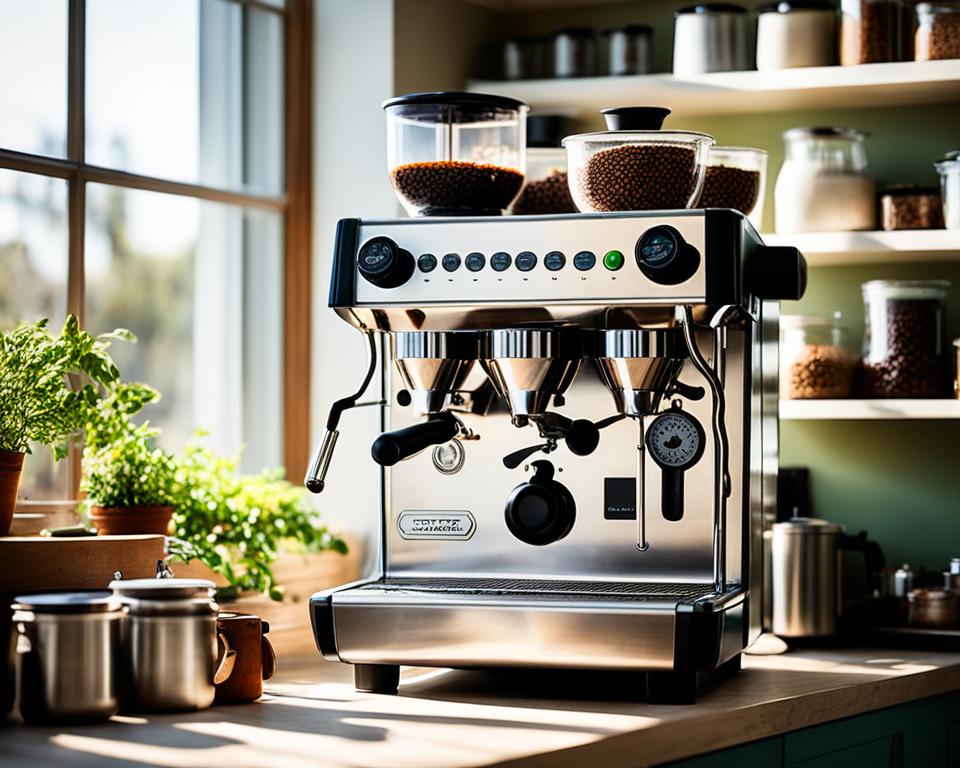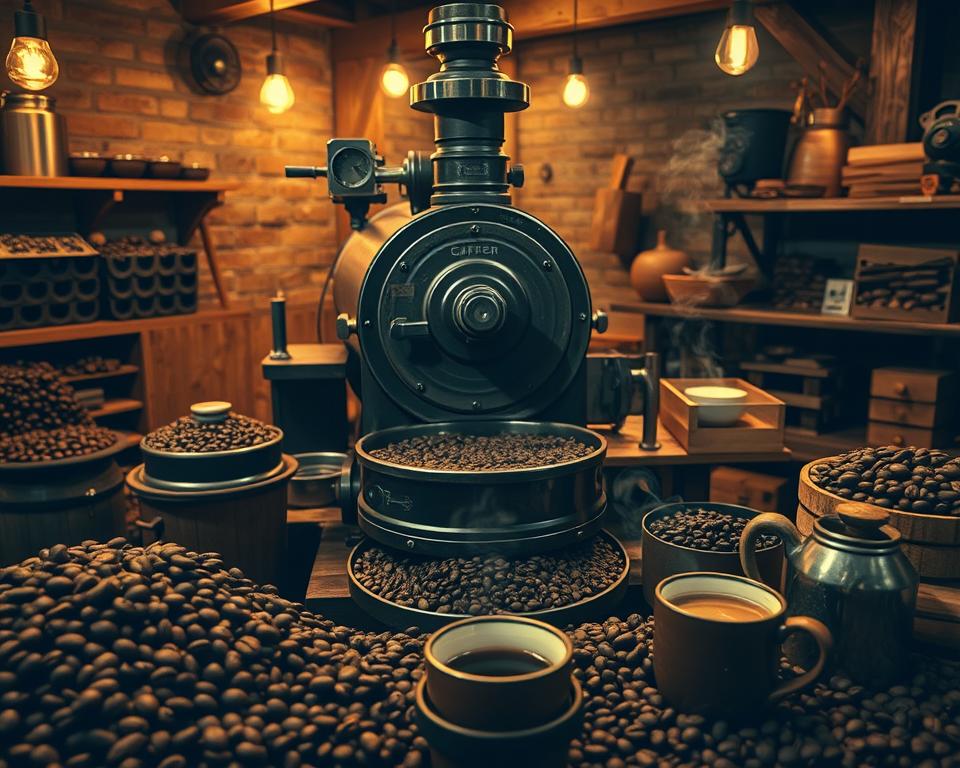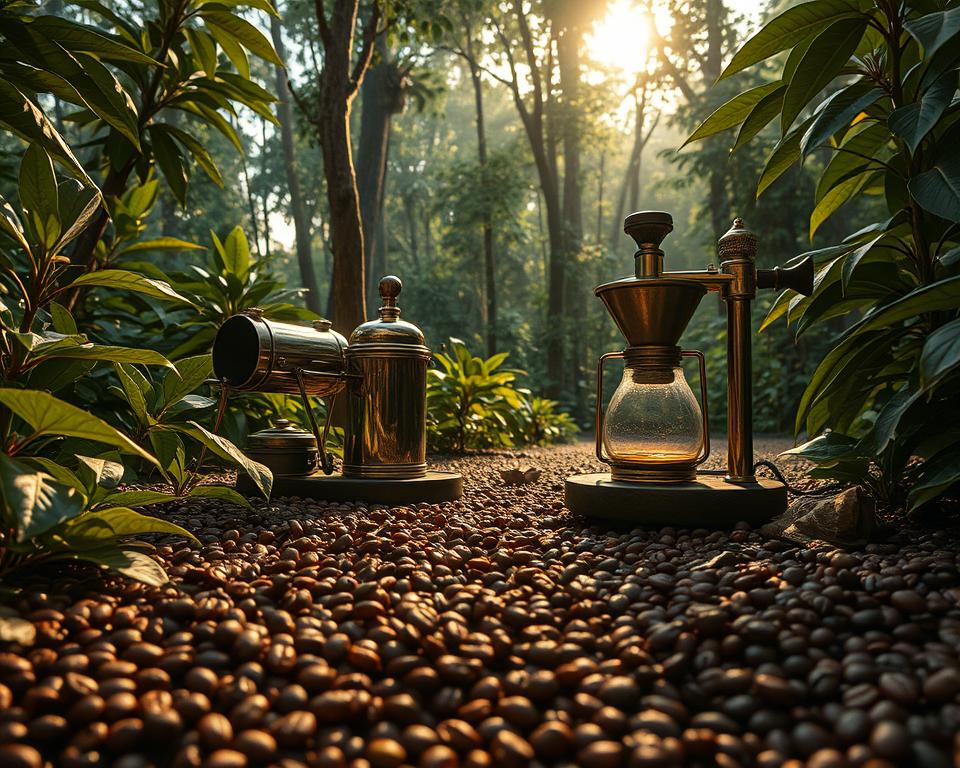Did you know that home coffee roasting can enhance the flavour of your beans dramatically, potentially saving you hundreds of dollars per year? Mastering the art of roasting transforms everyday coffee beans into rich, flavorful brews that coffee aficionados dream of. This coffee roasting guide aims to help you unlock those secrets, from understanding roast levels to achieving the perfect balance of flavours.
The journey to perfecting a roast begins with curiosity and a love for coffee. I’ll never forget the joy of my first successful roast—the aroma, the crackle of the beans, and the rich flavours that followed.
It’s a rewarding craft that turns enthusiasts into skilled home roasters, allowing you to achieve those ideal roast profiles tailored to your taste.
This coffee roasting guide aims to help you unlock those secrets, from understanding roast levels to achieving the perfect balance of flavors. Ready to dive into home coffee roasting and savour every cup?
Let’s start this flavorful journey together.
Understanding Coffee Roasting
The journey from green beans to a perfect roast is nothing short of magical. Each bean holds the promise of a unique flavour experience, waiting to be unlocked through the art of roasting.
Green beans for the perfect roast
Green beans, the raw form of coffee, carry the potential to develop various flavors. Selecting high-quality green beans is key to starting the roasting process on the right foot.
By understanding bean characteristics, like their origin and processing method, we can predict how they’ll taste once roasted. This knowledge allows us to tailor the roasting process to bring out the best in each batch.
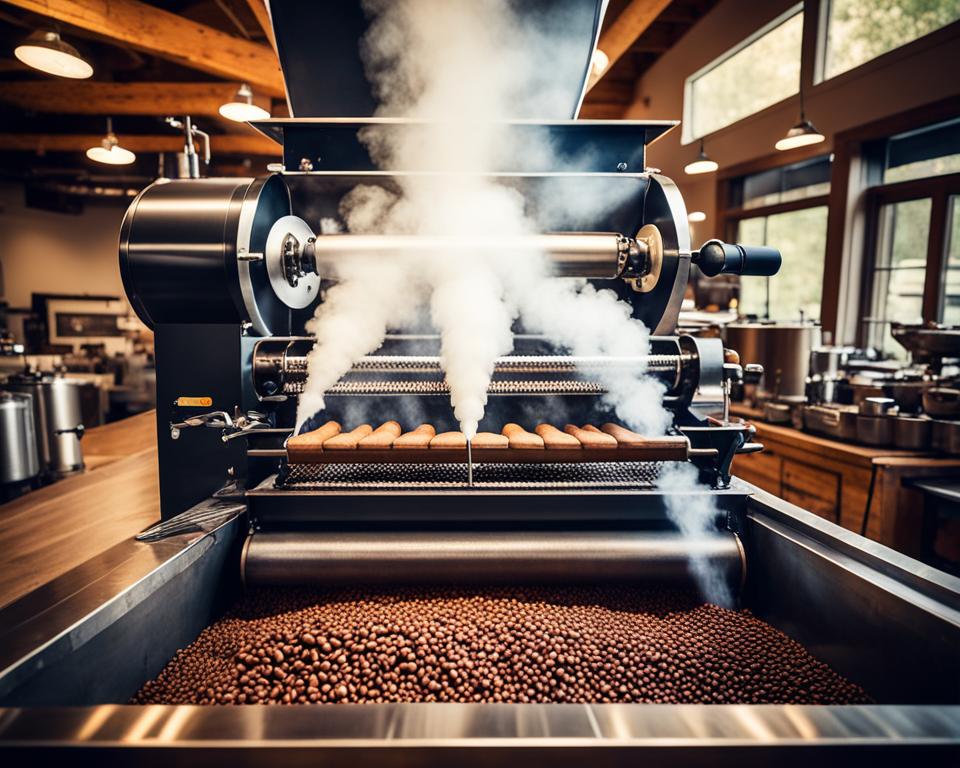
Have you ever noticed how different green beans look compared to their roasted counterparts? Not only do their colours change, but their aromas also transform significantly.
This transformation is crucial for flavour development, contributing to the complexity we savour in our coffee cups.
The role of temperature
Temperature plays a pivotal role in coffee roasting. It’s fascinating how varying the coffee roasting temperature can lead to different roast levels, from light to dark.
Each change in temperature affects the chemical reactions within the beans, which in turn shapes the flavour profiles.
Maintaining precise control over the coffee roasting temperature ensures that the desired flavour notes are achieved. As the beans heat up, they undergo several stages where their colours and aromas alter, indicating various phases of flavour development.
This is why paying attention to the roasting temperature of coffee is essential for creating rich, flavorful coffee.
Understanding how to manipulate temperature during the roasting process allows us to fine-tune the outcome, ensuring we achieve our perfect roast every time. It’s an art that takes practice but is incredibly rewarding.
Coffee Roasting Methods
Exploring various coffee roasting methods offers an exciting journey, whether you’re a DIY enthusiast or leaning towards a career in professional roasting.
Different approaches suit different needs, and understanding these can guide you to your ideal technique.
Home Roasters
Home coffee roasting methods range from simple to sophisticated. For many, DIY coffee roasting begins with pan-roasting. This budget-friendly technique involves roasting beans in a skillet on your stove.
Although it is hands-on, it can be tricky to achieve consistency. Another popular choice is using a popcorn popper, which can yield better results.
For those looking for greater control and precision, investing in a small coffee roasting machine is a game-changer. Brands like Behmor and Fresh Roast offer excellent entry-level professional roasting equipment that fits perfectly on a kitchen counter.
These machines provide features like adjustable temperature settings for experimenting with different roast techniques.
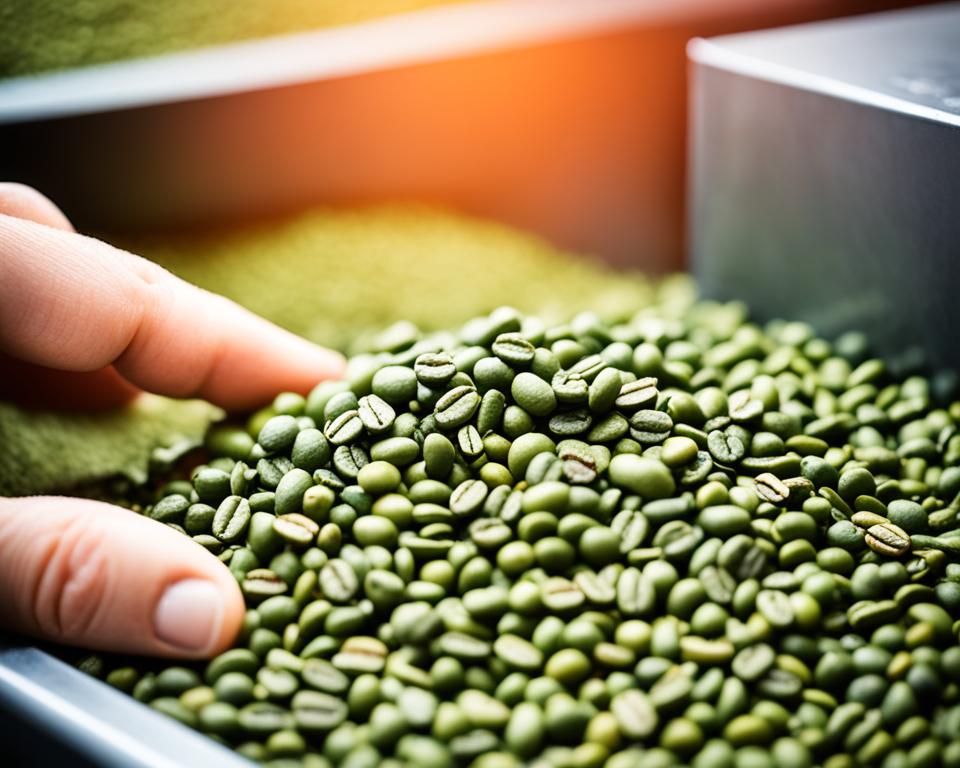
Commercial Roasters
Switching to commercial roasting involves scaling up operations significantly. Industrial roasters, like those from Probat and Diedrich, cater to larger volumes with exemplary precision.
These machines are designed for consistent output and optimal roast techniques, making them ideal for coffee shops and roasteries.
Choosing the right method depends on your goals. If you’re passionate about experimenting at home, the equipment needed for DIY coffee roasting can be relatively modest.
However, if your aim is to serve a wide audience, investing in professional-grade roasters and equipment is crucial. Always consider factors like cost, desired volume, and the level of control you wish to have over the roasting process.
Coffee Roasting Guide
Embarking on your coffee roasting journey starts with making informed decisions. Your choices play a crucial role in achieving the perfect cup.
Choosing Your Beans
Let’s talk about bean selection. The origin, variety, and processing methods significantly shape the flavour profile of your coffee. Whether it’s Ethiopian Yirgacheffe or Brazilian Santos, each bean type brings unique notes to the table.
Picking the right beans aligns with the roast profiles you wish to explore.
Consider these aspects:
- Origin: Coffee from different regions offers distinct flavours.
- Variety: Arabica and Robusta provide different taste experiences.
- Processing method: Washed, natural, or honey-processed beans impact your roast’s flavour.
Understanding these factors helps you make better choices, resulting in a more satisfying cup of coffee.
Cracking Sounds Explained
During the roasting process, you’ll hear two critical sounds known as the first crack and the second crack. These sounds signal key stages in developing your bean’s flavour and roast profile.
The first crack occurs as the beans release their moisture, making a popping sound similar to popcorn. This stage indicates your beans are transitioning from a dry state to a light roast.
Continuing past this point, you’ll encounter the second crack, a softer, more frequent cracking sound. This phase signals the beans transitioning towards a darker roast.
Ending the roast at different points between the first and second cracks helps in achieving light to dark roast profiles based on your preference.
By paying attention to these sounds, you can refine the roast level that brings out the best in your beans.
Common Mistakes to Avoid
Roasting coffee at home can be incredibly rewarding, but it’s easy to make mistakes that result in roasting errors.
Here are some common roasting pitfalls and how you can avoid them:
- Rushing the Process: Patience is key. If you rush, you may end up with burnt beans or an uneven roast. Take your time and follow each step to ensure a consistent flavour.
- Not Preheating Equipment: Always preheat your roasting equipment. An unpreheated roaster can cause temperature fluctuations that lead to roasting errors and poor flavour development.
- Ignoring Bean Cooling: Quickly cooling your beans after roasting is crucial. If you don’t, the beans will continue to cook, leading to burnt beans and an off-taste.
- Skipping Batch Checks: Keep an eye on each batch. Small deviations can lead to an uneven roast. Regularly check for consistency to avoid these common roasting pitfalls.
By being mindful of these roasting pitfalls, you’ll improve the taste and quality of your coffee. Don’t be afraid to experiment and learn from each batch.
Every mistake is a step closer to perfecting your roast.
Tasting and Refining Your Roast
One of the most exciting parts of home roasting is evaluating your coffee’s unique flavor profile through proper coffee tasting methods.
Setting up a tasting session will elevate your understanding of your roast and help you make precise adjustments.
Preparing a Tasting Session
To start, I ensure my tasting space is clean and free of other strong aromas. I set out multiple cups, a grinder, and freshly roasted coffee samples.
The process, known as cupping, involves brewing the coffee in small batches to evaluate the flavour notes. I make sure the water temperature and grind size are consistent for each sample.
When cupping, I focus on the aroma, body, sweetness, and aftertaste of each coffee. I always use a spoon to slurp the coffee; it helps spread the flavours evenly across my palate, making it easier to notice subtle differences.
Taking notes on these aspects helps track the distinct characteristics of each roast.
Adjusting Your Method
After a thorough cupping session, it’s time to refine my roast. Based on the feedback and my notes, I might decide that the roast needs a higher or lower temperature or a longer or shorter roasting time.
For instance, if the flavour notes seem too sour, I might increase the temperature next time. If it’s too bitter, I’ll consider reducing the roast time.
Roast adjustment is a continuous process. Each batch teaches me something new, and the more I experiment, the closer I get to achieving my perfect roast.
With each cupping, I fine-tune my methods, creating a coffee that mirrors my personal preferences.
Can the Techniques in a Coffee Roasting Guide Help Me Start My Coffee Roasting Business?
A comprehensive coffee roasting guide can be invaluable when starting your own coffee roasting business today. By understanding essential techniques such as temperature control, roast profiles, and bean selection, you’ll build a solid foundation. This knowledge enhances flavor consistency and boosts your confidence, positioning you for success in the coffee industry.
Conclusion
Embarking on the coffee journey to become a master roaster has been an exciting adventure. The lessons learned, both from successes and less-than-perfect attempts, have been invaluable. Each batch brought new insights, guiding me closer to the personalised roast I cherish.
Remember, the road to mastering coffee roasting is ongoing. It’s about embracing every experience, refining your techniques, and revelling in the discoveries along the way. When I first achieved my ideal flavour profile, it felt like a milestone, yet I knew it was only the beginning of an even richer journey.
I encourage you to continue experimenting and learning. Share your roasting stories and triumphs with fellow enthusiasts. After all, coffee roasting is not just about the end product; it’s about the joy and satisfaction of the process.
FAQ
What is the best method for home coffee roasting?
There are several methods for home coffee roasting, including pan-roasting, using a popcorn popper, or investing in a dedicated home coffee roaster.
Each method has its pros and cons, but using a home coffee roaster generally offers the most control and consistency for achieving your desired roast profiles.
How does temperature affect the coffee roasting process?
Temperature control is crucial in coffee roasting, as it influences the flavour development and chemical reactions within the beans. Proper management of coffee roasting temperature can help achieve specific roast levels and flavours, such as light, medium, or dark roasts. Too high a temperature can result in burnt beans, while too low might lead to uneven roasting.
Why are green beans important in coffee roasting?
Green beans are the raw, unroasted coffee beans and are the starting point in the coffee roasting process. The quality, origin, and processing method of green beans significantly affect the final flavour profile of the roasted coffee. Selecting high-quality green beans is essential for achieving the perfect roast and rich flavours.
What sounds should I listen for during roasting?
During roasting, listen for the “first crack” and “second crack,” which are audible indicators of the roasting stages. The first crack signifies the beans’ initial expansion and the release of moisture and gases, often associated with light-to-medium roasts. The second crack indicates a further breakdown of the bean structure, leading to darker roast profiles.
What are some common mistakes to avoid when roasting coffee?
Common mistakes include not preheating the roasting equipment, rushing the roasting process, and failing to cool the beans quickly after roasting. These errors can lead to uneven roasts or burnt beans, negatively affecting the taste. It’s important to follow best practices and take your time to achieve a consistent and high-quality roast.
How should I prepare for a coffee tasting session?
To prepare for a coffee tasting session, or cupping, start by brewing the freshly roasted coffee using a consistent method. Have some clean cups and spoons ready to sample and evaluate the coffee’s flavour notes. Pay attention to attributes like aroma, acidity, body, and aftertaste, and record your observations to refine your roasting technique.
How can I adjust my roasting method based on tasting results?
After a tasting session, use your feedback to fine-tune your roasting process. If the coffee tastes too bitter, you might want to reduce the temperature or shorten the roasting time. If it’s too acidic, consider extending the roast. Adjust variables like temperature, time, and method to achieve your preferred flavour profiles.

